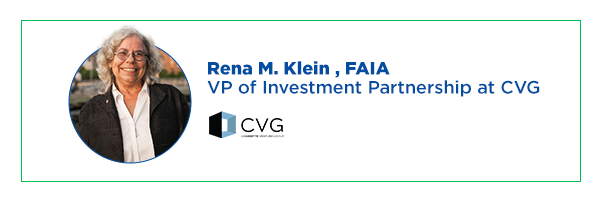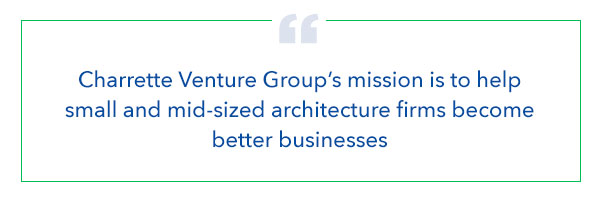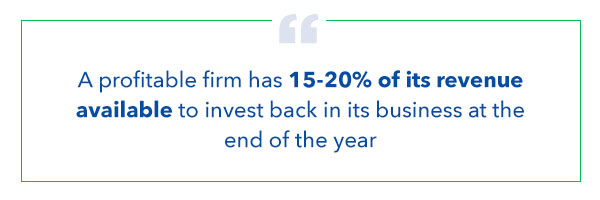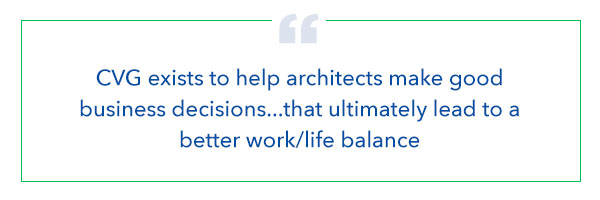How to Improve Profitability in Your Small Architecture Firm: Tips from Charrette Venture Group

No matter the industry, every business strives to be profitable. And while some businesses hit the ground running with a solid idea of how to get the most out of their products and marketing, many will likely need a little bit of assistance to accomplish their profit goals and get themselves on the right path for success in the long term.
That’s where a team like Charrette Venture Group (CVG) can help. CVG is a consulting business that works with small to mid-size architecture firms across the U.S. and Canada, helping them strategize marketing initiatives, set up effective financial planning, streamline daily operations, and more—all with the end goal of helping architecture firms reach their next level of success.
We sat down with Rena M. Klein, FAIA, VP of Investment Partnership at CVG to discuss her thoughts on architecture firm profitability and the role modern technology plays in maintaining a profitable business. Read our full interview below:

Tell us about yourself. What inspired you to pursue a career in the architecture industry?
I grew up outside of New York City and had the privilege of exposure to world-class museums and architecture at a young age. I decided I wanted to be an architect in high school, inspired by an art teacher who encouraged me to take that direction.
How did your career path lead you to join CVG?
After leading my own architecture practice in Seattle for about 12 years, I found myself dissatisfied. I was working many hours a week, making very little money, and I realized that my architectural training did not prepare me for running a business. I decided to go back to school, earned a graduate degree in management, and learned how to run my practice better.
Although I operated my practice for another 8 years, much of my attention turned to sharing my newly found knowledge with my colleagues in small firm practice. I started lecturing through AIA, teaching at the university level, writing about professional practice, and eventually established RM Klein Consulting to help other entrepreneurial architects.
Then CVG’s founder read an article that I wrote for the Association of Licensed Architects. He also became familiar with my book, The Architect’s Guide to Small Firm Management (Wiley, 2010). He reached out to me and, in 2017, I merged RM Klein Consulting with CVG and was brought on board as CVG’s second employee.

We’d love to know more about CVG. Can you give us an overview of the company and how its partnerships with architecture firms work?
Charrette Venture Group’s mission is to help small and mid-sized architecture firms become better businesses.
Our team of experts morphs around architecture firms to provide the business services and guidance they need to get to the next level of success. We roll up our sleeves to strategize, advise, and execute in leadership and management, finance, operations, recruiting, ownership transition, marketing, business development, organizational design, etc.
Most small architecture firms need a combination of the above services. That’s why CVG offers a whole systems approach, strategically applying our experience where and when it’s needed. We provide an alternative to typical consulting services: CVG both directs and helps implement our recommendations. Knowing small firm resources are limited, CVG steps in to fill the execution gaps.
Our actual business model is quite unique: our “bread and butter” is our Investment Partnership agreement, where we partner with a firm for five years and offer our services for a percentage of their net operating revenue. This is a shared-risk model. If the firm’s revenues don’t grow, ours don’t either. We’re incentivized to make our partners more profitable and sustainable from the inside out. There is no upselling. All meetings, calls, work hours, proprietary planning materials, and studio visits are included in our contract. We have weekly meetings with firm leaders to determine our work plan – and our team helps execute the tasks we outline.
What are some of the benefits and results firms experience when partnering with CVG?
Having analyzed the performance of our clients over time, we’ve found that the average revenue growth of firms partnered with CVG has increased 58% from the beginning of their contract to year’s-end 2019. The average annual profitability of firms partnered with CVG is 15.1%, whereas (according to Deltek Clarity Small Firms Study) the industry standard is 12.4%.
This information is from an analysis completed at the end of 2019—and we know what happened in 2020, so that’s not an average year, statistically. However, during the pandemic, we helped all of our investment partners understand the PPP loan program and successfully apply. We also helped them adjust budgets and projections in 2020 and 2021 so that they could strategically respond to the changing business environment in collaboration with experts instead of “going it alone.”
What does an unprofitable architecture firm look like, in your opinion?
We meet many firm leaders who struggle with profitability and financial management. Some of them actually think they are profitable, yet don’t pay themselves a market-rate salary, or barely pay themselves at all, which obviously negates their claim to be profitable.
Firms that don’t plan for profitability are much more negatively affected by shifts in workflow, cash flow, and staff turnover. They can’t invest in the things that they need to stabilize their businesses, like paying good wages or upgrading technology.

What are some of the most common mistakes they make that lead to them not being profitable?
The biggest and most common mistake is failing to plan. Firms can and should plan for profitability. We help firms do this by setting revenue goals, measuring progress towards these goals, setting budgets, and tracking expenses.
On a daily basis, we often observe architects ignoring project budgets for the sake of design, which we see as a false dichotomy. Or we see project teams who are not informed of the budget or told how many hours they are meant to spend on a task. CVG coaches firm leaders to re-think their attitudes toward fee and scope. Designing to the outlined scope, and not overdelivering or allowing “scope creep,” should become part of a firm’s culture, if it is not already. This starts from the top.
How can small firms effectively balance managing their profits and providing a satisfactory service to their clients?
Setting expectations clearly from the beginning is critical. Many of our firms have had success with tiered proposals that outline “good, better, best” fee options that clearly delineate the level of service and deliverables at each tier. After the fact, if a client asks for more, the architect can refer to the selected tier and note that the client didn’t select that option, therefore justifying an additional cost.

What does a profitable architecture firm look like?
A profitable firm has 15-20% of its revenue available to invest back in its business at the end of the year. This can take many forms: bonuses, distributions, charitable contributions, infrastructure investments, or cash reserves.
What are the top 3 things an architecture firm should do to have a profitable business?
- Make an annual strategic plan that includes financial modeling.
- Carefully track time and monitor project budgets regularly.
- Create a culture of attention to profit within the firm, where employees respect this as a goal and know how they can contribute to the firm’s financial health.
What type of business planning should an architecture firm do to work toward being a profitable business?
CVG models financial pro formas with our clients, estimating that each employee should translate to approximately $120K - $130K in revenue. So, naturally, growing your staff should mean growing your revenue, assuming operations and business development are being executed effectively. This is why we look holistically at a firm’s annual strategic plan: finance, operations, marketing, and culture must work together to result in a profitable business.
Do you believe that new forms of payment like online payments could impact the profitability of an architecture firm in a positive way?
Yes. Whatever tools a firm can recommend making payment easier for their clients should be used.
Note: ClientPay helps simplify your billing process by not only providing the convenience of paying online, but by expanding your payment options to accept credit cards, debit cards, eChecks, and QR code payments.
Which kinds of technology investments do you think can lead to the most significant boosts in profitability for architecture firms?
Adopting project management software—and using it consistently—can help firms understand their project’s budgets and how they are performing in real-time. We like Monograph, but there are several other useful programs available.

How do you think the payment experience affects profitability? What can architects do to improve the payment experience?
The payment experience should be as easy as possible. Payment should also be divorced from project phases, so a client can’t hold an invoice in the interest of not starting the next phase of the project. We’ve seen equal installment billing work well, where the full fee is divided over time and billed a flat rate every month. This is also helpful for an architecture firm’s cash flow planning.
Note: ClientPay’s Scheduled Payments feature is an excellent way to implement equal installment billing into your firm. With this feature, you can arrange for a client’s payment information to be automatically billed for a specific amount each month until a total has been reached.
Are there technology investments architecture firms can make to streamline their bookkeeping process?
We recommend outsourcing bookkeeping services, unless your firm is large enough to have a specialist in-house.
What is one practice today's architecture firms should take advantage of that you believe will help their bottom line?
Accurate and consistent time-tracking.

Why should architecture firms consider partnering with a consulting services firm?
We know that students don’t learn much about running a business in architecture school. Sure, there are some firm leaders who are naturally business-savvy, or self-taught, or expertly mentored, but the overwhelming majority of firm leaders feel like they are winging it. CVG exists to help architects make good business decisions...that ultimately lead to a better work/life balance.
What does 2021 look like for CVG and its partners?
We are growing by leaps and bounds! CVG just signed our 30th Investment Partner. We’re finding an increased interest in our services, which is likely because we’ve been in business for enough years (seven) that the design firm community has seen the positive impact CVG continues to have.
We want to thank Rena M. Klein, FAIA, for the industry insights she provided in this interview. For more information about Charrette Venture Group, visit charrettevg.com.
Want to see how a specialized online payment solution can help improve your firm’s profitability? Schedule a demo of ClientPay today!